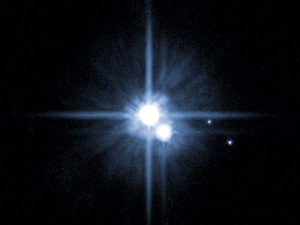 Pluto (center, largest) and its moons Charon, Nix,
Pluto (center, largest) and its moons Charon, Nix,
and Hydra captured by the Hubble Space Telescope.In the past year, the quiet and unassuming Pluto has been having its moments of fame. First was the attention brought by the launch of NASA’s New Horizons spacecraft, the robot that, when it arrives at Pluto nearly a decade from now, will give us our first up-close look at this cold, distant, and tiny world. Myself, I can hardly wait.
Then last August, the astronomers of the International Astronomical Union (IAU) got together to debate and vote on a scientific definition for the word planet (because that’s what the IAU does, among other things). Alas for Pluto, the ratified scientific definition of planet was a standard that Pluto didn’t quite measure up to, and our Solar System suddenly had eight official planets.
Personally, I've made my peace with this--and I like the way my daughter put it: "Dad, I’m sad because, guess what? Pluto isn't a planet anymore. But guess what? It's now a dwarf planet! Cool!"
However Pluto may have been treated by the IAU, an upcoming astronomical event serves as a reminder that this far-flung, icy dwarf planet has gone on with its life, serenely unaffected by human debate.
On March 18, close to 4:00 AM Pacific Daylight Time (yes, Daylight Savings Time starts early this year), Pluto will pass in front of a star—a star about as bright as Pluto itself—casting a faint shadow onto the Earth in a much less showy version of a solar eclipse, when the Moon passes in front of the Sun. This type of event is called an occultation.
